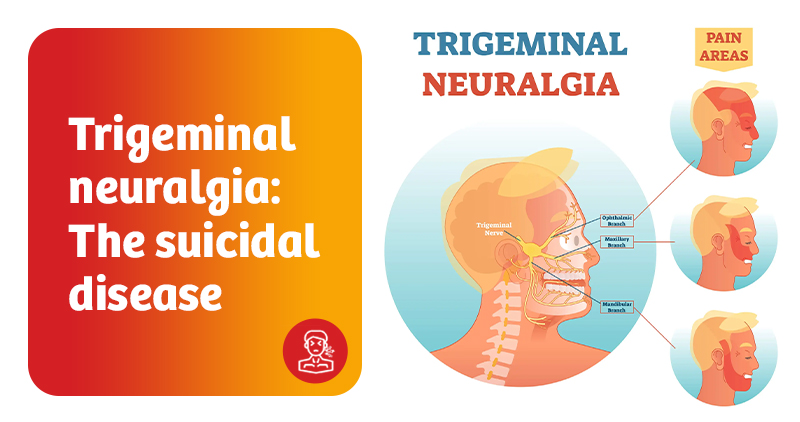

By Dr Sandip Modh
Senior Consultant Endovascular Neurosurgeon
July 10, 2025
Recently, the term trigeminal neuralgia gained public attention when a superstar opened up about battling it.
But what exactly is it? Is it life-threatening? And more importantly, is it manageable?
Yes, it can become severely debilitating if not treated with the right clinical interventions.
However, with timely diagnosis and expert care, trigeminal neuralgia is manageable, and patients can regain a good quality of life.
Trigeminal neuralgia (TN) is often called the 'suicide disease' for a reason — it causes episodes of sudden, severe, electric shock-like facial pain that can severely impact the quality of life. Though rare, it is one of the most painful neurological conditions known to medicine. The good news is that with accurate diagnosis and modern medical and surgical treatment options — such as those available at KD Hospital, Ahmedabad — relief is possible.
Trigeminal neuralgia is a chronic pain condition that affects the trigeminal nerve, one of the most widely distributed nerves in the head. The trigeminal nerve has three branches
When this nerve becomes compressed or irritated, it misfires, sending erratic pain signals to the brain, even in response to mild stimulation.
The most common cause of TN is compression of the trigeminal nerve root by a blood vessel near the brainstem. This constant pressure damages the protective covering of the nerve (myelin sheath), causing abnormal nerve signals.
Trigeminal neuralgia is not your usual facial pain. Its symptoms are highly characteristic and may include
As the condition progresses, pain attacks may become more frequent and intense, severely disrupting daily life and mental health.
Trigeminal neuralgia is classified into two types
1. Classical (Type 1) trigeminal neuralgia
2. Atypical (Type 2) trigeminal neuralgia
Trigeminal neuralgia is primarily diagnosed clinically, based on history and symptoms. To establish a definitive diagnosis and exclude other possible conditions, diagnostic tests are essential.
Trigeminal neuralgia vs other facial pain disorders
| Feature | Trigeminal neuralgia | Glossopharyngeal neuralgia | Post-herpetic neuralgia |
| Nerve involved | Trigeminal nerve (cranial nerve V) | Glossopharyngeal nerve (cranial nerve IX) | Sensory nerves post-herpes zoster |
| Pain location | Cheek, jaw, gums, lips, sometimes eye and forehead | Throat, tonsils, ear, back of tongue | Same area as past shingles rash |
| Nature of pain | Sudden, electric shock-like, brief | Sharp, stabbing pain, often triggered by swallowing | Burning, persistent, may follow a rash |
| Pain duration | Seconds to a few minutes, recurring | Seconds to minutes, episodic | Ongoing or chronic |
| Common triggers | Light touch, brushing teeth, chewing, breeze | Swallowing, coughing, talking | Temperature changes, light touch |
| Additional features | No visible signs, pain-free intervals | Ear pain or difficulty swallowing | Rash in the affected area |
| Treatment approach | Medications, microvascular decompression, radiosurgery | Nerve blocks, medications, surgery | Antivirals, pain medications |
MRI Brain with contrast: To detect vascular compression or tumours MR angiogram: Helps visualise blood vessels causing nerve compression Neurological examination: Assesses sensory and motor function Early diagnosis is crucial. Delays can result in prolonged suffering and inappropriate treatments like dental extractions, which offer no relief.
KD Hospital's multidisciplinary neurology and neurosurgery team offers a personalised approach to trigeminal neuralgia management. Depending on severity and response, treatment includes
1. Medications
Many patients become resistant to medications over time or cannot tolerate side effects, necessitating surgical options.
2. Minimally invasive procedures
3. Radiofrequency rhizotomy
4. Glycerol injection
5. Balloon compression
All procedures are available at the KD Hospital's Advanced Neuro-Intervention Centre, which features state-of-the-art imaging and neuronavigation support.
1. Surgical treatment: Microvascular decompression (MVD)
For patients with vascular compression who are eligible for surgery, microvascular decompression is the most definitive treatment.
Living with trigeminal neuralgia: Psychological and social impact
Beyond physical pain, trigeminal neuralgia often causes severe emotional distress, leading to
At KD Hospital, a holistic approach is followed, involving
It ensures that patients don't just survive trigeminal neuralgia — they thrive again.
Why choose KD Hospital for trigeminal neuralgia treatment?
Q1: Is trigeminal neuralgia the same as migraine or dental pain?
No. Trigeminal neuralgia is nerve pain, often misdiagnosed. Unlike migraines or dental issues, TN pain is sudden, electric, and usually one-sided.
Q2: Is trigeminal neuralgia curable?
While not always 'curable,' many patients achieve long-term relief through medication or surgery.
Q3: Can trigeminal neuralgia return after treatment?
Yes, especially after non-surgical methods. Surgical treatment like MVD offers the best chance for long-lasting relief.
Q4: Is surgery safe?
When done by experienced neurosurgeons like those at KD Hospital, surgery is very safe and often life-changing.
Q5: When should I seek help?
If you have facial pain that is sudden, one-sided, and triggered by normal activities, see a neurologist immediately.
"I used to cry every day. Brushing my teeth or even a breeze would cause unbearable shocks. I was misdiagnosed for 2 years until I came to KD Hospital. Dr Sandip Modh and his team identified trigeminal neuralgia and guided me through surgery. Today, I am pain-free and have my life back."
– Mrs Seema R., Age 48, Surat
Leading hospital in Ahmedabad for Neurology and Neurosurgery.
Trigeminal neuralgia is not just pain — it is life-altering suffering that often goes unrecognised. But with early diagnosis, expert intervention, and personalised care, recovery is possible.
At KD Hospital, Ahmedabad, patients with trigeminal neuralgia find not just cutting-edge treatment options but also hope, compassion, and support through their journey.